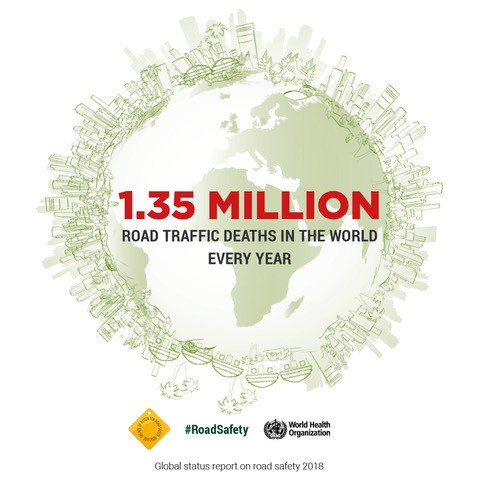RADAR - 1.35 million road traffic deaths in the world, every year
17-12-2018
A new report by the World Health Organization (WHO) indicates road traffic deaths continue to rise, with an annual 1.35 million fatalities. The WHO Global status report on road safety 2018 highlights that road traffic injuries are now the leading killer of children and young people aged 5-29 years.

The WHO Global status report on road safety 2018 documents that despite an increase in the overall number of deaths, the rates of death relative to the size of the world population have stabilized in recent years. This suggests that existing road safety efforts in some middle- and high-income countries have mitigated the situation.
In the settings where progress has been made, it is largely attributed to better legislation around key risks such as speeding, drinking and driving, and failing to use seat-belts, motorcycle helmets and child restraints; safer infrastructure like sidewalks and dedicated lanes for cyclists and motorcyclists; improved vehicle standards such as those that mandate electronic stability control and advanced braking; and enhanced post-crash care.
3-star or better standard roads by 2030
The status report also includes the Global Voluntary Performance Target for Road Safety Risk Factors that have been agreed by UN Member States to help governments measure and manage road safety. Target 3 is aimed at ensuring the safety of all news roads by meeting a 3-star or better standard for all road users by 2030.
The report highlights the importance of improving the safety performance for all road user groups and captures progress in the institutional management of road safety, legislation and road user behaviour, safe roads, safe vehicles and post-crash care. Results are available at a global level and a country level to help guide priorities for action. The good news is 48 countries have reduced road deaths but sadly 104 countries saw an increase in the number of road deaths between 2013 and 2016.
Higher death rates in low-income countries
The report shows that these measures have contributed to reductions in road traffic deaths in 48 middle- and high-income countries. However, not a single low-income country has demonstrated a reduction in overall deaths, in large part because these measures are lacking.
In fact, the risk of a road traffic death remains three times higher in low-income countries than in high-income countries.
For instance, the Danube area consists of very different countries. On one hand, the area includes Austria, which have highly developed and highly traffic-laden road systems, and on the other hand there are countries that are still developing their road network. Large parts of the Danube road network rate poorly for safety, particularly for vulnerable road-users, and death rates in many countries are higher than the EU average. Many countries lack professional capacity and approaches to the problem vary.
Horrible statistics: more than 7.000 people killed on roads in Danube area

According to status report of WHO, more than 7.000 people were killed on the roads of Danube area in 2016*. Many cases suggest that these numbers annually cost up to 2 % of countries GDP. Large parts of the Danube road network rate poorly for safety, particularly for vulnerable road-users, and death rates in many countries are higher than the EU average.
Many countries lack professional capacity and approaches to the problem vary. Main issue in most countries across the Danube area is that road infrastructure is often inefficient or simply missing.
The project RADAR will implement learning and transnational cooperation activities to help the relevant organisations in the Danube area to identify risk on their road networks and help them reduce risk systematically by improving road infrastructure and roads’ layout. RADAR addresses all road-users but pays particular attention to vulnerable road users and safety on major roads near schools. It also approaches the issue of safety in a holistic way and tackles speed as a major risk on roads.
The WHO Report provides the definitive snapshot of global road safety performance and provides both accountability and inspiration for action. Action that will save lives through safer roads, safer vehicles, safer road users and the road safety management and post-crash care that can reduce the tragic loss of life and unacceptable injury levels on the world’s roads.
*WHO estimated road traffic fatalities in the Danube area, including Austria, Bosnia and Herzegovina, Bulgaria, Croatia, The Czech Republic, Hungary, Montenegro, Moldova, Romania, Serbia, Slovakia and Slovenia.
